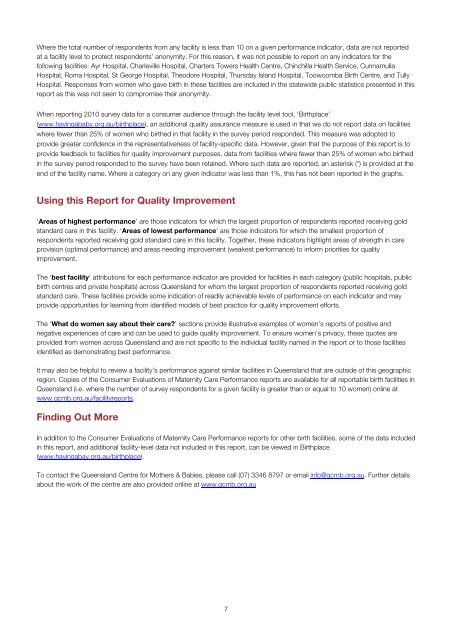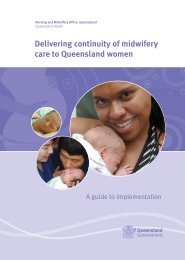Proserpine Hospital - Queensland Centre for Mothers & Babies
Proserpine Hospital - Queensland Centre for Mothers & Babies
Proserpine Hospital - Queensland Centre for Mothers & Babies
You also want an ePaper? Increase the reach of your titles
YUMPU automatically turns print PDFs into web optimized ePapers that Google loves.
Where the total number of respondents from any facility is less than 10 on a given per<strong>for</strong>mance indicator, data are not reported<br />
at a facility level to protect respondents’ anonymity. For this reason, it was not possible to report on any indicators <strong>for</strong> the<br />
following facilities: Ayr <strong>Hospital</strong>, Charleville <strong>Hospital</strong>, Charters Towers Health <strong>Centre</strong>, Chinchilla Health Service, Cunnamulla<br />
<strong>Hospital</strong>, Roma <strong>Hospital</strong>, St George <strong>Hospital</strong>, Theodore <strong>Hospital</strong>, Thursday Island <strong>Hospital</strong>, Toowoomba Birth <strong>Centre</strong>, and Tully<br />
<strong>Hospital</strong>. Responses from women who gave birth in these facilities are included in the statewide public statistics presented in this<br />
report as this was not seen to compromise their anonymity.<br />
When reporting 2010 survey data <strong>for</strong> a consumer audience through the facility level tool, ‘Birthplace’<br />
(www.havingababy.org.au/birthplace), an additional quality assurance measure is used in that we do not report data on facilities<br />
where fewer than 25% of women who birthed in that facility in the survey period responded. This measure was adopted to<br />
provide greater confidence in the representativeness of facility-specific data. However, given that the purpose of this report is to<br />
provide feedback to facilities <strong>for</strong> quality improvement purposes, data from facilities where fewer than 25% of women who birthed<br />
in the survey period responded to the survey have been retained. Where such data are reported, an asterisk (*) is provided at the<br />
end of the facility name. Where a category on any given indicator was less than 1%, this has not been reported in the graphs.<br />
Using this Report <strong>for</strong> Quality Improvement<br />
‘Areas of highest per<strong>for</strong>mance’ are those indicators <strong>for</strong> which the largest proportion of respondents reported receiving gold<br />
standard care in this facility. ‘Areas of lowest per<strong>for</strong>mance’ are those indicators <strong>for</strong> which the smallest proportion of<br />
respondents reported receiving gold standard care in this facility. Together, these indicators highlight areas of strength in care<br />
provision (optimal per<strong>for</strong>mance) and areas needing improvement (weakest per<strong>for</strong>mance) to in<strong>for</strong>m priorities <strong>for</strong> quality<br />
improvement.<br />
The ‘best facility’ attributions <strong>for</strong> each per<strong>for</strong>mance indicator are provided <strong>for</strong> facilities in each category (public hospitals, public<br />
birth centres and private hospitals) across <strong>Queensland</strong> <strong>for</strong> whom the largest proportion of respondents reported receiving gold<br />
standard care. These facilities provide some indication of readily achievable levels of per<strong>for</strong>mance on each indicator and may<br />
provide opportunities <strong>for</strong> learning from identified models of best practice <strong>for</strong> quality improvement ef<strong>for</strong>ts.<br />
The ‘What do women say about their care’ sections provide illustrative examples of women’s reports of positive and<br />
negative experiences of care and can be used to guide quality improvement. To ensure women’s privacy, these quotes are<br />
provided from women across <strong>Queensland</strong> and are not specific to the individual facility named in the report or to those facilities<br />
identified as demonstrating best per<strong>for</strong>mance.<br />
It may also be helpful to review a facility’s per<strong>for</strong>mance against similar facilities in <strong>Queensland</strong> that are outside of this geographic<br />
region. Copies of the Consumer Evaluations of Maternity Care Per<strong>for</strong>mance reports are available <strong>for</strong> all reportable birth facilities in<br />
<strong>Queensland</strong> (i.e. where the number of survey respondents <strong>for</strong> a given facility is greater than or equal to 10 women) online at<br />
www.qcmb.org.au/facilityreports.<br />
Finding Out More<br />
In addition to the Consumer Evaluations of Maternity Care Per<strong>for</strong>mance reports <strong>for</strong> other birth facilities, some of the data included<br />
in this report, and additional facility-level data not included in this report, can be viewed in Birthplace<br />
(www.havingabay.org.au/birthplace).<br />
To contact the <strong>Queensland</strong> <strong>Centre</strong> <strong>for</strong> <strong>Mothers</strong> & <strong>Babies</strong>, please call (07) 3346 8797 or email info@qcmb.org.au. Further details<br />
about the work of the centre are also provided online at www.qcmb.org.au<br />
7
















